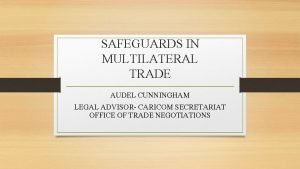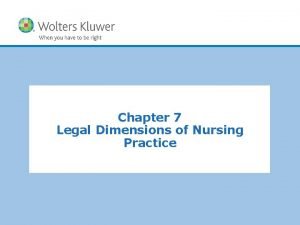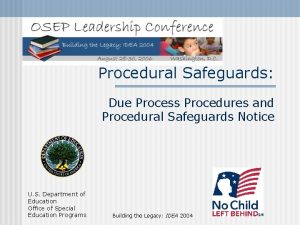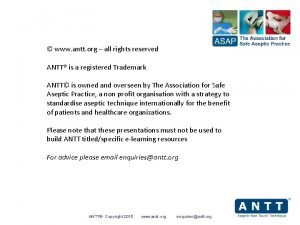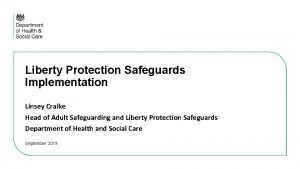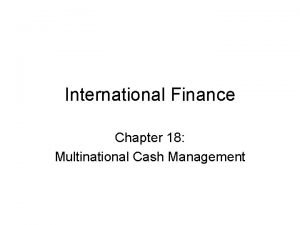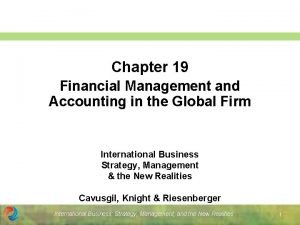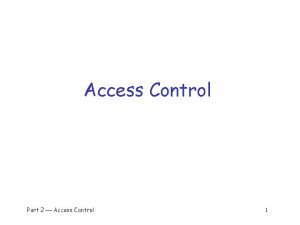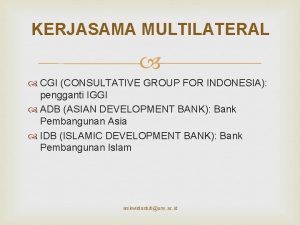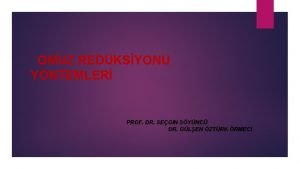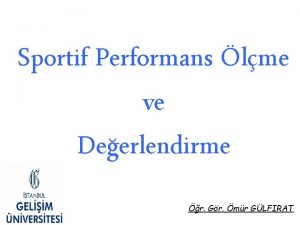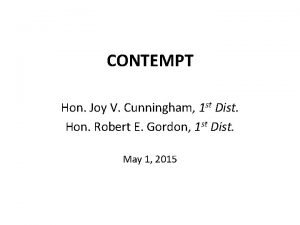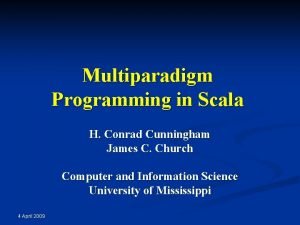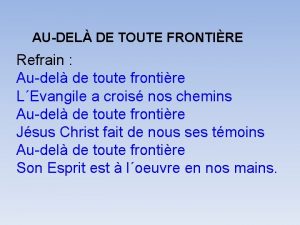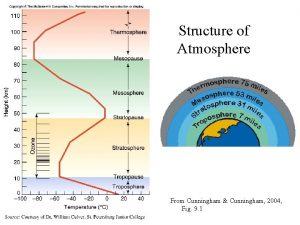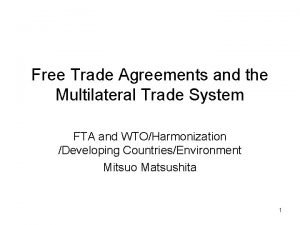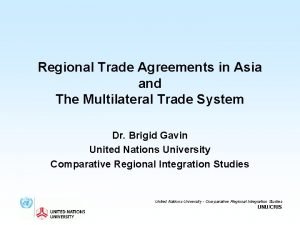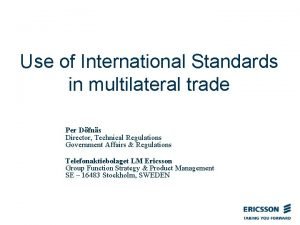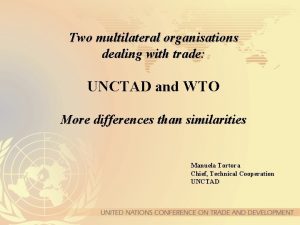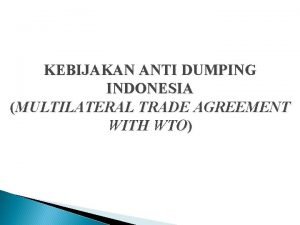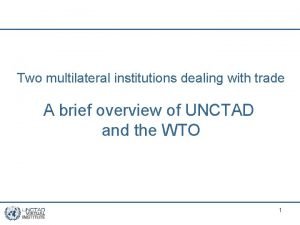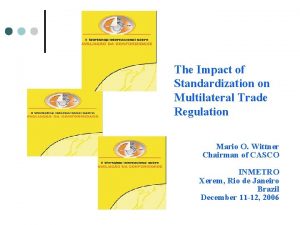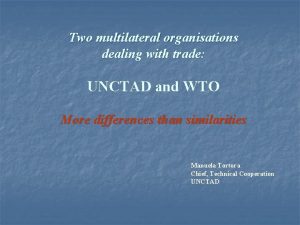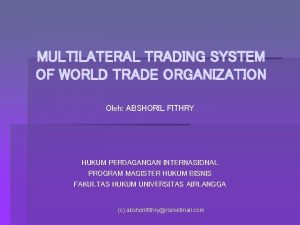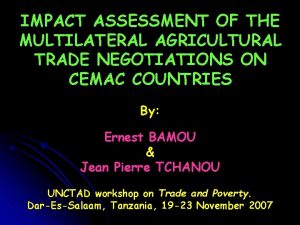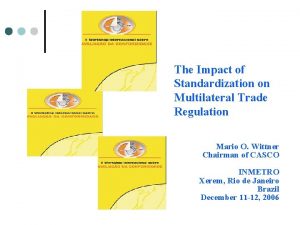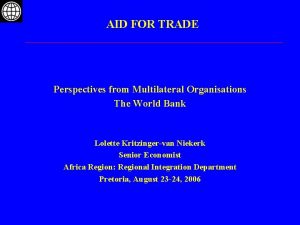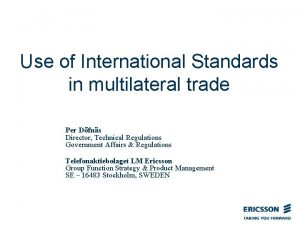SAFEGUARDS IN MULTILATERAL TRADE AUDEL CUNNINGHAM LEGAL ADVISOR





































- Slides: 37

SAFEGUARDS IN MULTILATERAL TRADE AUDEL CUNNINGHAM LEGAL ADVISOR- CARICOM SECRETARIAT OFFICE OF TRADE NEGOTIATIONS

IMPORTANT ISSUES TO BE ADDRESSED: 1. How can a safeguard be of benefit to domestic producers in CARICOM? 2. How easy is it to adopt and maintain WTO compatible safeguards? 3. What are the pros and cons of adopting safeguards?

CONCEPTUAL NATURE OF A SAFEGUARD Safeguards are: (i) A contingent trade remedy, i. e. their use is contingent on a given set of factual and legal circumstances (ii) A permissible restriction on international trade in carefully defined circumstances (i. e. exception to the general rules of trade liberalization) (iii) Extraordinary or exceptional measures (iv) Not dependent on existence of “unfair” trade practices

CONCEPTUAL NATURE OF SAFEGUARDS CONT’D. • Note the notion of safeguards being a safety valve in the multilateral trade arena: “If WTO law were not to offer a 'safety valve' for situations in which, following trade liberalization, imports increase so as to cause serious injury or threat thereof to a domestic industry, Members could be deterred from entering into additional tariff concessions and from engaging in further trade liberalization. It is for this reason that the safeguard mechanism in Article XIX has always been an integral part of the GATT. . . “ [From report of the Panel in US-Lamb]

SAFEGUARDS: LEGAL CRITERIA 1. Article XIX of GATT 1994: WTO member may impose safeguard where: (i) As a result of unforeseen developments, and (ii) Effect of obligations incurred under the GATT (tariff concessions etc) there is: (iii) (iv) Product being imported in increased quantities and under such conditions As to cause or threaten to cause serious injury to domestic producers of like or directly competitive products

SAFEGUARDS: LEGAL CRITERIA CONT’D. For WTO compatible safeguards there must be in all cases : • • • Proof of increased imports (absolute or relative to domestic production) Proof of injury or threat of injury to domestic industry Existence of domestic industry producing like or directly competitive products Demonstration of how incurred obligations have led to injury to domestic industry Demonstration of unforeseen circumstances

UNFORSEEN DEVELOPMENTS • “…unforeseen developments" should be interpreted to mean developments occurring after the negotiation of the relevant tariff concession which it would not be reasonable to expect that the negotiators of the country making the concession could and should have foreseen at the time when the concession was negotiated. [GATT Working Party Hatters’ Fur Case – 1951] Does this suggest that safeguards will not be available in response to increased imports arising from tariff elimination under a FTA? ?

Case Study on Unforeseen Developments Dominican Republic: Safeguard Measures on Imports of Polypropylene Bags and Tubular Fabric The DR suggested that the following were unforeseen developments: - China’s accession to the WTO - Tariff liberalization under the Central America – DR FTA and the US-DRCAFTA - Were these really unforeseen developments?

CASE STUDY ON UNFORSEEN DEVELOPMENTS Jamaica: Safeguards on Portland Grey Cement The Commission found unforeseen developments to exist as a result of: Excess capacity arising from Asian economic crisis Global oversupply - Matters not foreseeable at time when Jamaica assumed the WTO commitments

EVALUATION OF INCREASED IMPORTS • IA must evaluate all relevant factors of an objective or quantifiable nature having a bearing on the situation of the domestic industry. In particular, the IA must examine: (i) Rate and amount of the increase in imports of the product concerned ( in absolute and relative terms) – The increase must be sufficiently recent, sharp and significant enough to cause of threaten to cause serious injury (ii) Market share of imports in importing country (iii) Changes in level of sales, production, productivity, capacity utilization, profits and losses and employment.

DETERMINING THE DOMESTIC INDUSTRY • Safeguards are for protection of domestic industry. This means that IA must first determine whether such an industry exists. • Domestic Industry speaks to : Domestic producers of like or directly competitive products

Determining the scope of the domestic industry • Like product is : - Product which is identical in all respects to or has characteristics closely resembling another product. • Directly competitive product is: - Product which although not necessarily like another one, is in a directly competitive relationship with another product:

DETERMINING “LIKENESS” To determine likeness and/ or directly competitive relationship examine: (a) (b) (c) (d) Physical characteristics Consumer tastes End use Quality etc

CASE STUDY Jamaica: Cement The Commission found that imported Portland Grey Cement was a like product to the Portland Grey Cement produced by the local manufacturer because: • Similar production process • Substantially the same physical and chemical characteristics • Consumers did not appreciate one to be appreciably better than the other (quality and performance characteristics)

DETERMINING INJURY • Nature of injury is serious injury of threat of serious injury. [either one or other or both in combination] • This is a higher standard than “material injury” in AD and CVD cases

WHAT IS INJURY? • Serious injury is: “Significant overall impairment in the position of a domestic industry. ” • Threat of serious injury is: Injury that is clearly imminent. Must be based on facts. Cannot be based on allegation, conjecture or remote possibility. • Imminent injury- Injury which is on the “very verge of happening”

INJURY ANALYSIS- CAUSATION The IA cannot make an affirmative finding of injury unless: • Based upon objective evidence, there is the existence of a causal link between increased imports of the product and serious injury or threat of serious injury to the domestic industry. N. B NON-ATTRIBUTION RULE: Factors apart from increased imports which are injuring the domestic industry at the same time, must not be attributed to the increased imports

CASE STUDY Jamaica: Cement The Commission found serious injury: Injurious effects in price undercutting and price depression but not in price suppression Injurious effects in inventory, sales and market share Negative effects seen in profits and return on investments but not cash flows, productivity, employment or wages

IMPLEMENTING A SAFEGUARD • Safeguard must be on MFN basis. (Applied to all sources of imports) • But possible exception for FTA partners

FORM OF THE SAFEGUARD • Safeguard may take the form of a tariff based measure (tariff increase or tariff rate quota), or quantitative restriction. Quantitative restrictions: Level of quotas: • Not below average level of last 3 years Unless clear justification for another level is given • Allocation of a quota must be in accordance with the MFN principle

SAFEGUARDS: INVESTIGATION PROCEDURE A safeguard can only be imposed following: - Public investigation conducted by IA. - Reasonable public notice to all interested parties - Public hearings or other appropriate means by which importers, exporters or other interested parties can present evidence and their views on issues such as whether safeguard is in public interest. They must also be afforded the opportunity of responding to presentations etc other interested parties. -

OBLIGATIONS OF THE INVESTIGATING AUTHORITY • IA must publish report setting out findings and reasoned conclusions on all pertinent issues of fact and law. • IA must PROMPTLY publish detailed analysis of the case and a demonstration of the relevance of the injury factors examined

OBLIGATIONS OF THE INVESTIGATING AUTHORITY • Published report of IA must contain reasoned conclusion on unforeseen developments. • IA must conduct adequate assessment of the impact of the increased imports and the specific market under investigation. • Must examine conditions of competition between the imported product and the domestic like or directly competitive products.

PROVISIONAL SAFEGAURD MEASURES May be imposed on temporary basis before end of the investigation where: - Critical circumstances where delay would cause damage difficult to repair, and - Preliminary determination by IA that there is clear evidence that increased imports have caused or are threatening to cause injury. - Not longer than 200 days duration [counted as part of duration of definitive measure] - Can only take the form of tariff increases and the increased duty collected must be refunded if investigation does not establish injury caused by the increased imports

DURATION OF SAFEGUARD • Safeguard measures shall only be applied to extent necessary to prevent or remedy serious injury and to facilitate adjustment. • Period not to exceed 4 years, but can be extended where determination by IA that the measure continues to be necessary to prevent or remedy serious injury and there is evidence that the domestic industry is adjusting. • Total duration of safeguard cannot exceed 8 years (note developing country exception)

CASE STUDY Jamaica: Cement The Commission recommended a safeguard in the form of a tariff of 25. 83 % for 4 years. In order to preserve competition in marketplace and to facilitate adjustment by the local industry, the Commission “reserved the right to recommend” that the safeguard be liberalised no earlier than end of second year of application: 2% at end of second year, 3% at end of third year Measure applied in addition to MFN tariff of 15%

OBLIGATIONS OF IMPOSING MEMBER 1. In cases where safeguard lasts over 1 year, must progressively liberalize it at regular intervals during period of application so as to facilitate adjustment by the domestic industry. 2. Where measure lasts for more than 3 years, must review situation no later than mid-term of measure and if appropriate, must withdraw it or increase pace of liberalization. 3. Extended measure should not be more restrictive than it was at end of the initial period and should continue to be liberalized. 4. Limits on ability to re-impose safeguard

OBLIGATION TO OFFER COMPENSATION • Member State imposing a safeguard must seek to maintain substantially equivalent level of concessions to exporting members. • Must enter into consultations with members having substantial interest as exporters of the product. Members may agree on trade compensation.

DEVELOPING COUNTRY PROVISIONS • No application of safeguard measures against product originating in developing country where share of exports of product concerned in importing member is less than 3 %. But: • May be cumulation where developing countries with less than 3% collectively account for more than 9% of total imports of the product. Note DR Case Study

DEVELOPING COUNTRY PROVISIONS • Developing country can apply safeguard for maximum period of ten years • Developing country can apply new measure to a product after period of time amounting to half of duration of previous measure but : -period of non-application must be at least 2 years.

ALTERNATIVES TO A SAFEGUARD • Carefully constructed tariff commitments: DR Case Study

CARICOM SAFEGUARDS In accordance with Art 92 of the RTC, a CARICOM Member State can impose restrictions on imports of products from another Member State if: The imports cause serious injury or threat of serious injury to domestic producers of like or directly competitive products in any industry or sector of any industry

CARICOM SAFEGUARDS Restrictions can only be imposed if: (i) The imports result in a substantial decrease in demand for the like or directly competitive products produced within its jurisdiction, or (ii) The decrease in demand is directly linked to an increase in imports consigned from another Member State

SAFEGUARDS IN FTAs • FTAs may (a)reaffirm WTO obligations, (b) outlaw safeguards, (c) have more stringent criteria, or (d) have less stringent criteria for safeguards • Safeguards may be tied to the transitional period for tariff liberalisation

SAFEGUARDS IN FTAs Note for example, the CARIFORUM-EU EPA: - Safeguards may be adopted where increased imports cause or threaten to cause (a) disturbances in a sector of the economy or disturbances, particularly where those disturbances produce major social problems or difficulties which could bring about serious deterioration in the economic situation of the state or (b) disturbances in the markets of like or directly competitive agricultural products

SAFEGUARDS IN FTAs TT – Panama Partial Scope Agreement: Either party may apply a bilateral safeguard if it is necessary to redress balance of payment deficits or to protect the external financial position of the importing party

FIN THANK YOU FOR YOUR ATTENTION QUESTIONS? ? ?
 Audel cunningham
Audel cunningham Legal safeguards for nurses
Legal safeguards for nurses Tag questions we often watch tv in the afternoon
Tag questions we often watch tv in the afternoon Due process safeguards
Due process safeguards Micro critical aseptic field
Micro critical aseptic field Liberty protection safeguards flowchart
Liberty protection safeguards flowchart Objectivity safeguards in research process
Objectivity safeguards in research process Multinational netting
Multinational netting Multilateral netting is used primarily to
Multilateral netting is used primarily to Multilateral peering tokyo
Multilateral peering tokyo The multilateral security enforces access control
The multilateral security enforces access control Multilateral interoperability program
Multilateral interoperability program Unilateral competition games examples
Unilateral competition games examples Multilateral competition games
Multilateral competition games Cgi bergerak di bidang
Cgi bergerak di bidang The trade in the trade-to-gdp ratio
The trade in the trade-to-gdp ratio Triangular trade
Triangular trade Trade diversion and trade creation
Trade diversion and trade creation Fair trade not free trade
Fair trade not free trade Trade diversion and trade creation
Trade diversion and trade creation Trade diversion and trade creation
Trade diversion and trade creation Trade diversion and trade creation
Trade diversion and trade creation Tramp trade software
Tramp trade software Kocher yöntemi
Kocher yöntemi To kill a mockingbird questions chapter 1
To kill a mockingbird questions chapter 1 Kyla cunningham
Kyla cunningham Definition of curriculum by cunningham
Definition of curriculum by cunningham ömür gülfırat
ömür gülfırat Claude cunningham
Claude cunningham Cunningham
Cunningham Joy cunningham
Joy cunningham Soft taffeta-like sounds
Soft taffeta-like sounds Conrad cunningham
Conrad cunningham Conrad cunningham
Conrad cunningham Robert abrams breanna cunningham
Robert abrams breanna cunningham Cecilia cunningham
Cecilia cunningham Statistics sample rates conor cunningham
Statistics sample rates conor cunningham Frances cunningham finch
Frances cunningham finch
